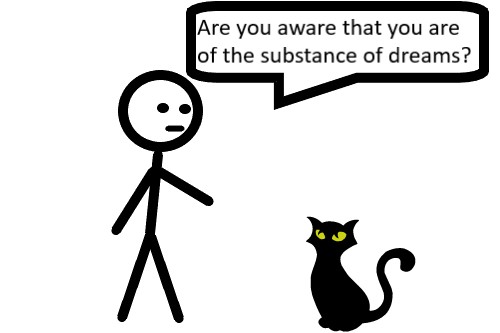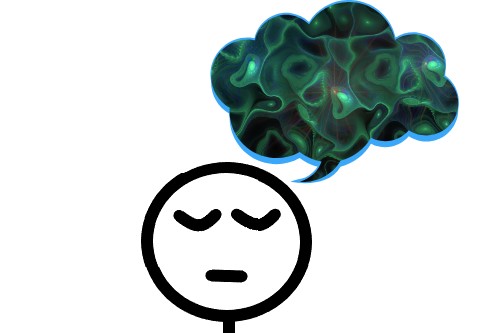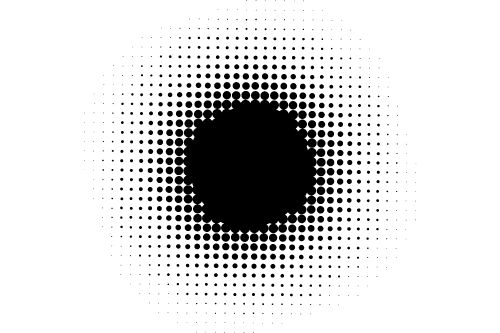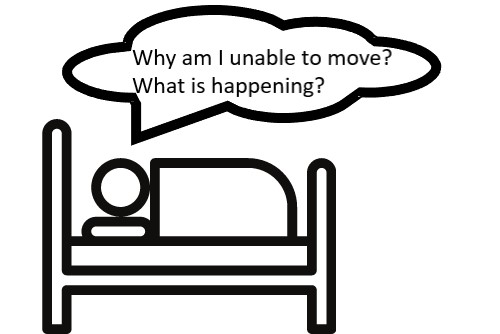What is Lucid Dreaming?
Reading this article on lucid dreaming techniques I assume you already know what lucid dreaming is.
Yet, if you came here by a happy accident and don’t know what lucid dreaming is, let me explain.
Lucid dreaming is being aware that you are dreaming in a dream. Basically, you are awake in a dream.
If you never had a lucid dream the closest thing to compare it to is your current state of consciousness. Your everyday waking state of consciousness. But it still is an altered state of consciousness.
The only difference is in a lucid dream you are not bound by any physical constraints. Your imagination is the limit.
“Dreams are a reservoir of knowledge and experience, yet they are often overlooked as a vehicle for exploring reality. In the dream state our bodies are at rest, yet we see and hear, move about, and are even able to learn. When we make good use of the dream state, it is almost as if our lives were doubled: instead of a hundred years, we live two hundred.” – Tarthang Tulku, Openness Mind
Why Should You Learn to Lucid Dream?
Now you might wonder is it really worth it to learn lucid dreaming?
The short answer is, absolutely! And most people who have had lucid dreams would agree.
Between a quarter and half of our life, we spend sleeping. And most of us spend our time sleeping through our dreams. I don’t want to say that you are wasting a part of your life by doing that.
But you are certainly missing out on adventures and lessons that could change your life.
Being awake in your dreams will not only enrich your experiences of dreams. Lucid dreaming can also improve your waking life.
We can carry knowledge and moods into waking life. When you wake up from a wonderful lucid dream the rest of the day or even week can be filled with increased joy and happiness.
This can also happen to some extent in non-lucid dreams. Perhaps you had the experience yourself where a dream colored the mood for the day.
If you never had a lucid dream it is definitely worth a try. It’s a mind-blowing experience to wake up in a dream. And it can have a significant positive impact on your life.
When I had my first lucid dream, I had a sense of unlimited freedom and possibilities unparalleled.
If you are still not convinced read at least some of the parts of this article. Sometimes just reading about lucid dreaming is enough to induce your first lucid dream.
Prerequisites for Learning Lucid Dreaming Techniques
Motivation to Learn Lucid Dreaming
I guess this is an obvious one. Motivation is essential. Lucid dreaming requires some effort, especially in the beginning stages of learning.
But if you practice the techniques for lucid dreaming you will be able to have lucid dreams.
Some people might achieve success earlier. For others, it may take a while longer. Some even have a talent for lucid dreaming and are able to effortlessly have lucid dreams.
However, don’t be discouraged. Everyone can learn lucid dreaming.
Make Time for Sleeping
Another essential for lucid dreaming is… sleeping (what a surprise!). What you want are longer REM (rapid eye movement)-sleep periods. Those are the active sleep periods where most of the dreaming happens.
There are two things to keep in mind about REM sleep:
1. The length of the REM periods increases as the night proceeds.
2. The interval between the REM periods decreases with the time of the night.
Hence, the chance to have lucid dreams increases in the later morning hours. Pressing the snooze button multiple times before finally waking may also increase the chances of lucid dreaming.
Unfortunately, many of us don’t have time to sleep late into the morning hours.
Still, I suggest choosing one day a week where you give yourself time to stay in bed longer and practice lucid dreaming techniques.
Dream Recall and Keeping a Dream Journal

Before you practice techniques for lucid dreaming you should be able to recall at least one dream every night.
Another important factor is keeping a dream journal. This has two benefits:
• You’ll get better at dream recall
• You’ll get familiar with your dreams and can identify reoccurring patterns
Whenever you wake up and remember a dream immediately write it down. We all know how elusive our memory of dreams can be. So, keep your dream journal close to your bed.
With time you will recognize dream signs. These are reoccurring themes, things, people, places, actions you name it.
Dream signs can often trigger a lucid dream.
Practicing Willpower
Practicing your willpower is often overlooked. But this can make a difference when having success with lucid dreaming. Because techniques for lucid dreaming are essentially mental training.
You need the willpower to write your dreams down in an awakening period even if your bed is super cozy. And some techniques work best when you get up and stay awake for 10 minutes before going to bed.
Other techniques require prolonged mental focus and awareness.
Here are some “useless” exercises to practice willpower:
• Stand on a chair for five minutes
• Move fifty paper clips from one box to another, one at a time, deliberately and slowly
• Get out of bed fifteen minutes earlier than necessary in the morning
• Observe a candle flame for ten minutes
You can make up your tasks as well. What’s important is trying to feel content while performing them. Don’t be impatient and try to rush them.
Strong willpower will help you with the following lucid dreaming techniques. Moreover, willpower is not only beneficial for lucid dreaming but life in general. So, exercising your will is really worth it.
Lucid Dreaming Techniques
There are many different techniques to achieve lucid dreams. I have divided this section into two distinct types of lucid dreams. The first one is dream-induced lucid dreams (DILDs) and the second one is wake-induced lucid dreams (WILDs).
The majority of lucid dreams are DILDs and most people have their first success with this type of technique. Nonetheless, I suggest you try the lucid dreaming techniques that speak to you most and see which one works best for you.
The effectiveness of any technique also partly depends on your individual physiology and psychology. So, if one technique doesn’t do it for you try another one.
Techniques for Waking Up in The Dream World
The following is a compilation of DILDs. If you are new to lucid dreaming, I suggest you try those first before you try WILDs. This is because they are generally easier for the novice oneironaut (= ”explorer of the dream world”).
Critical State-testing Technique

Critical state-testing is the lucid dreaming technique you should start with. I would say it’s almost a prerequisite to achieving lucid dreams.
In this technique, you are making it a habit to ask yourself: “Am I dreaming or awake, right now?”
Seriously, ask yourself right now.
The goal of this is to eventually ask yourself if you are dreaming in a dream, which then leads to a lucid dream.
By frequently questioning your state of consciousness you’ll develop a “critical-reflective attitude” towards it. In dreams, the critical faculty is usually dormant. This means that something unusual or even impossible is not recognized as such in a dream.
By asking the question if you are dreaming as often as possible you exercise your critical faculty.
Try to ask yourself the “critical question” as often as possible (at least five to ten times a day).
Do this preferably in situations that are somewhat dream-like. You can make a list of five situations where you’ll test your state. For example, one situation could be when you go to a bathroom.
When you ask yourself if you are dreaming don’t just quickly dismiss it and be like: “of course I’m awake.”
Look for clues. Effective ways to test if you are dreaming or not:
• Read a text, then look away and reread it. (In dreams the text often changes.)
• Look at a digital watch twice. (In dreams digital watches don’t make sense.)
• Hold your nose shut and try breathing through your nose. (In dreams you’ll be able to breathe through your nose despite holding it shut. Worked for me every time.)
• Try to fly. (If you’re airborne for even a split second you can be sure that you’re dreaming.)
Choose one method for state testing and use it every time.
“Anytime you seriously find yourself suspecting that you just might be dreaming, you probably are!” – Stephen LaBerge, Exploring the World of Lucid Dreaming
Power of Resolution Technique

This technique for lucid dreaming is derived from Tibetan Buddhism. Its goal is “comprehending the dream state by the power of resolution”.
What you try to do is to maintain unbroken continuity of consciousness throughout the waking and the dream state. Meaning you want to achieve a consistent state of awareness.
Hence, this approach has a day and a night practice.
During the day continuously be aware that “everything is of the substance of dreams”. This means that your experience is a construction of your mind. Resolve that you will realize its true nature.
The idea is that by spending enough time thinking “everything is of the substance of dreams” during the day, you will eventually have that thought while you are dreaming.
When you go to sleep at night firmly resolve that you will comprehend the dream state.
As an optional bonus, you can ask for help from the wisest part of yourself. Or even pray to a symbolic figure you have associated with lucid dreaming.
Intention Technique
Many people have occasional spontaneous lucid dreams. Yet, lucid dreaming rarely occurs without intending it.
This is especially true if you want to have lucid dreams more frequently. Hence, you have to cultivate an intention to recognize that you are dreaming.
Stephen LaBerge outlines three steps for the intention technique:
1. Resolve to recognize dreaming
In the morning or during an awakening period confidently affirm your intention to remember to recognize the dream state.
2. Visualize yourself recognizing dreaming
Visualize yourself in a dream situation that would cause you to realize that you are dreaming. Here you can include your most common dream signs and patterns.
3. Imagine carrying out an intended dream action
Also, resolve to carry out a particular action in your dream and visualize yourself doing it. For the best results pick an action that is itself a dream sign. You can, for instance, see yourself flying and thus recognize that you are dreaming.
Setting the intention to do a specific action is helpful. This is because in a dream you might remember to do the action before becoming lucid. As a result, you may recognize that you are dreaming.
That’s also why the action should be one of your dreamsigns, as you’ll be more likely to realize that you are in a dream.
Reflection-Intention Technique
This lucid dreaming technique is a combination of the critical-state testing and intention technique.
The following four steps are adapted from the late psychologist and dream researcher Paul Tholey:
1. Plan when you intend to test your state
The first step is to choose different occasions and situations where you intend to ask yourself if you are dreaming. In addition, to your selected occasions and situations, ask yourself this question when you are in a situation that is in any way dream-like.
The more often you remember to test your state the better will your results be.
2. Test your state
Ask yourself, “Am I dreaming or awake?” Then look around for any inconsistencies that might indicate that you are dreaming. If you have trouble remembering what happened several minutes ago or how you got into this situation you could be dreaming.
Use one of the state-testing methods. Read text twice or look at a digital watch. Don’t conclude that you are awake until you have definite proof.
3. Imagine yourself dreaming
Now that you are sure you are not dreaming, ask yourself what it would be like if you were dreaming. Vividly imagine yourself dreaming. Observe your imagined dream environment and look for your dreamsigns.
What would it be like if a dreamsign was present? As soon as you experience yourself as if in a dream, tell yourself: “The next time I’m dreaming, I will remember to recognize that I’m dreaming.”
4. Imagine doing what you intend to do in your lucid dream
Decide what it is you would like to do in a lucid dream. Now continue your fantasy and imagine yourself, after becoming lucid, acting out your intended action.
Testing your state might be weird in the beginning. But regularly questioning the nature of reality can become quite an enjoyable habit. And sooner or later you’ll do it in a dream and thus become lucid.
MILD Technique
Among the techniques for lucid dreaming, I found the Mnemonic Induction of Lucid Dreams (MILD) to be especially effective.
Psychologist and dream researcher Stephen LaBerge developed MILD as part of his Ph.D. dissertation work. With this technique, he learned to have lucid dreams virtually at will.
MILD Prerequisites
Before trying the MILD technique, you should be able to remember intentions without any external reminders.
What LaBerge suggests is choosing four target events per day where you intend to do a state test. For example:
• The next time you see a pet
• The next time you write something down
• The next time you drink something
• The next time you check the time
The goal is to notice the target once, the next time it happens.
Choose four targets for each day of the week and then see how many target events you hit. Do this until you can hit most targets.
The MILD technique
1. Set up dream recall
Before going to bed resolve to wake up and recall dreams during each dream period, sometimes in the early morning, or any time you find convenient (you can use an alarm as an aid).
2. Recall your dream
When you awaken from a dream period, try to remember as many details from your dream as possible. Better yet write the dream in your dream journal and read it over as preparation for the next steps.
If you are sleepy do something to wake yourself up. For instance, get up and walk around.
3. Focus your intent
While going back to sleep focus on your intention to remember that you’re dreaming. Tell yourself: “Next time I’m dreaming, I want to remember that I’m dreaming.” Really mean it. If your thoughts start to drift gently return to your intention.
4. See yourself becoming lucid
At the same time imagine yourself being back in the dream you have just awakened from. However, this time you realize that you are dreaming. Find a dreamsign and tell yourself: “I’m dreaming!” Then continue your fantasy by carrying out your intended dream action.
5. Repeat
Repeat steps 3 and 4 until your intention is set, then let yourself fall asleep. The last thing you think of before falling asleep should be your intention to remember to recognize that you are dreaming.
And then hopefully you’ll find yourself in a dream, at which you’ll remember to realize that you are dreaming.
Note: The longer you are awake before returning to sleep the higher is your chance to have a lucid dream. This has two reasons:
1. You have more time to repeat the MILD procedure, strengthening your intention.
2. Wakefulness activates your brain, which makes becoming lucid easier.
Autosuggestion Technique
This lucid dreaming technique is not as effective as other techniques. Yet it requires not as much effort as other techniques.
Autosuggestion should be done right before bed in a relaxed state. It’s important to note that an effort of will must be avoided.
Trying too hard is counterproductive in this approach.
The first step is to relax completely. Release all muscular and mental tension. Focus on your breathing and let go of the thoughts, worries, concerns, and plans of the day.
Then in a deeply relaxed state suggest to yourself to you are going to have a lucid dream later that night or some other night. Avoid putting intentional effort into your suggestion.
Put yourself in a state of mind of genuinely expecting to have a lucid dream soon. Look forward to it but let it happen by its own means.
Techniques for Falling Asleep Consciously
Wake-Initiated Lucid Dreams (WILDs) are a different approach to lucid dreaming. DILDs are intended to stimulate a dreamer to become lucid within a dream.
WILDs, however, are based on the idea of falling asleep consciously.
As stated, earlier WILDs are generally less frequent than DILDs. In addition, WILDs always happen in association with a brief awakening. Meaning you wake up and immediately return to REM sleep.
Also, WILDs are most likely to happen in the early morning hours or in afternoon naps.
In general, WILDs take considerable practice. Yet when mastered WILDs will enable you to induce lucid dreams virtually at will.
Hypnagogic Imagery Technique

This is the most common WILD technique. While falling asleep you focus on the hypnagogic imagery that accompanies dream onset. Russian philosopher P.D. Ouspensky called these “half-dream states”.
This lucid dreaming technique includes three steps.
1. Relax completely
Like most methods, you start by relaxing completely. Letting go of muscular and mental tension as stated in the earlier techniques.
2. Observe the visual images
Now you gently focus on the mental images that appear before your mind’s eye. Observe them as cautiously as possible and see where they begin and end. Don’t try to hold on to the images. Just watch them passively as they unfold.
Try to take the perspective of a detached observer as much as possible. Gradually, patterns will turn into images and the images will turn into complex scenes.
3. Enter the dream
When the imagery becomes a moving vivid scenario allow yourself to be passively drawn into it.
It’s important to not try to actively enter the dream scene. This will usually cause the scene to disappear.
Allow your involvement to what is happening draw you into the dream. But be aware too much involvement and too little attention can cause you to forget that you are dreaming.
Step 3 is the most difficult one. The biggest challenge is to keep an objective observer perspective. Which then draws you into the dream.
Another risk with this lucid dreaming technique and WILDs, in general, is that you lose lucidity once you have entered the dream.
To prevent this you can resolve to carry out an action as soon as you enter the dream. So, if you lose lucidity you might remember your intended action and regain lucidity.
Relaxed (“pot-shaped”) Breathing
This is not really a lucid dreaming technique per se. However, the following lucid dream induction techniques involve what is called “pot-shaped” breathing.
You can practice this in a comfortable sitting position or laying down (be aware not to fall asleep though).
Rest your hands on your abdomen so that your middle fingers meet at the naval and your thumbs rest on the bottom of your ribcage.
Start by taking a long, slow inhalation, followed by a long, slow exhalation. Then continue to breathe in a pattern that is a little slower and deeper than normal.
Now, notice your midsection. Focus on your hands and you’ll notice how your diaphragm and belly muscles contribute to the inhale and exhale. Feel all the muscle groups as you inhale and exhale.
Allow your breath to find a calm but regular rhythm. Don’t try to force the breathing. Allow your diaphragm and solar plexus to contribute more to the “pot-shaped” phase of your breathing. This means that your belly should extend out roundly during inhalation.
Imagine yourself inhaling nourishing light as you inhale. And as you exhale send this light through your body. Feel the light (oxygen) flow to every cell of your body providing it with energy and nutrients.
Power of Visualization: White and Black Dot Technique
These two lucid dreaming techniques stem from Tibetan dream yoga.
Both the white and black dot techniques have a before bed and at dawn practice.
White Dot Technique

Before bed
1. Firmly resolve to recognize when you are dreaming.
2. Visualize the syllable ah red in color in your throat (where the throat chakra is located). Note: Ah is the seed syllable of the throat chakra. It is viewed as the embodiment of the Creative Sound and has the power to bring a world into being.
3. Mentally focus on the radiance of the ah. Imagine it revealing all things in the world to be of the nature of dreams
At dawn
1. Practice pot-shaped breathing seven times (see above).
2. Resolve eleven times to comprehend the nature of the dream state.
3. Concentrate your mind upon a point (colored in white) between your eyebrows.
4. Continue to focus until you find yourself in a dream.
If you fail to induce a lucid dream with the white dot technique, the Yoga of the Dream State advises trying the black dot technique.
Black Dot Technique

Before bed
1. Meditate on the white dot between your eyebrows (see white dot technique).
At dawn
1. Practice pot-shaped breathing 21 times.
2. Resolve to recognize the dream state 21 times.
3. Then, focus your mind on a pill-sized black dot at the base of the sexual organ.
4. Continue your focus until you find yourself in a dream
Dream Lotus and Flame Technique

This lucid dreaming technique comes from the Tibetan Buddhist teacher Tarthang Tulku.
The flame represents awareness. This is the same awareness of being awake and asleep. Hence, it represents the continuity of awareness from wakefulness to sleep. And this is our goal.
In Buddhism, the Lotus represents the process of spiritual growth. It grows out of muddy waters where it transcends earth and water to open up its many-petaled flower to receive the pure light. This is a metaphor for spiritual understanding. As you reach it you outgrow the material world. Your roots are in the dark depths of the material world but your understanding is raised into the pure light.
As you practice this lucid dreaming technique keep the symbolic meaning in mind.
1. Relax completely
Once again relaxing is the first step. Focus on your breathing and let go of all muscular and mental tension. If you have just awakened you might be sufficiently relaxed already.
2. Visualize the flame in the lotus
As soon as you feel fully relaxed start your visualization. In your throat visualize a beautiful lotus flower with soft, light-pink petals. In the center of the flower imagine a glowing flame with reddish-orange light.
Try to see the flame as clearly as possible and keep the visualization up as long as possible.
3. Observe your imagery
Observe how your lotus and flame interact with other images that come up in your mind. Don’t try to intellectualize any of these images. Instead, continue to maintain your visualization.
4. Blend with the image and the dream
Maintain the visualization until your awareness and the image of the lotus and the flame merge together. You’ll then no longer have to consciously visualize it because you’ll just see it.
Eventually, you’ll find yourself dreaming.
If you have no experience with visualization you may find this method rather difficult. Visualizing clear images takes some practice for most.
As a practice, you can concentrate on an actual candle flame in front of you. This will strengthen your concentration and provide a vivid memory of a flame. After focusing on the candle for 5 minutes you may close your eyes and visualize the flame as vivid and detailed as possible.
After improving your skills to visualize this lucid dreaming technique should get easier.
Count Yourself to Sleep Technique
The basis of this technique is to focus your mind using a cognitive task that takes minimal but conscious effort.
You focus on the task until your perception of the environment disappears and you fall asleep. But as long as you perform the mental task your mind will remain awake.
This technique was developed by Stephen LaBerge.
1. Relax completely
You know the drill. Relax the body completely. Let go of thoughts, worries, and concerns (they can wait).
2. Count to yourself while falling asleep
While you are drifting off to sleep, count to yourself. “1, I’m dreaming; 2, I’m dreaming,…” and so on. If you reach 100 you may start over from 1. Try to remain somewhat alert.
3. Realize you are dreaming
After doing the counting and reminding process for some time, at some point you’ll say: “I’m dreaming.” and find that you are indeed dreaming.
The phrase “I’m dreaming.” Is not necessary but helps to remind you of your intention.
Sleep Paralysis

When you focus on your body while falling asleep you may notice mysterious physical sensations. Vibrations, extreme distortions, or even feelings of paralysis may occur.
These sensations are part of sleep and especially REM sleep onset. During REM sleep almost all of the muscles are paralyzed so you don’t act out your dream actions in the waking world.
You may have had the experience of awakening but your body still being paralyzed. This is called sleep paralysis.
For first-timers, this can be a terrifying experience.
You might feel like you are suffocating, or an evil presence is in your room. But this is just how your half-dreaming brain is interpreting this unusual condition.
So don’t worry sleep paralysis is harmless.
It is not only harmless but can be used for entering a lucid dream. You already have one foot in the dream world. Just step over and voilà you’re lucid dreaming.
The following three lucid dreaming techniques will help you make that step.
The No, One, and Twin Body Techniques
The body techniques for lucid dreaming are pretty similar. The difference is the view of how many (if even) bodies we have.
The first step for all the body techniques is the same.
When you wake up from a dream close your eyes and lay on your back or right side. If you are not relaxed enough tighten and release your muscles from your face to your legs to relax more deeply. Let go of all muscular and mental tension and breathe slowly and calmly.
Then enjoy the state of relaxation and affirm your intention to consciously enter a dream.
The second step in the twin bodies and one body techniques is to focus on your physical body.
Pass your attention through your whole body. Notice any strange sensations, distortions, and vibrations. These are signs of REM sleep paralysis.
Eventually, these sensations will develop into complete paralysis of your physical body. Now you are ready to leave your paralyzed body behind and enter the dream world.
Twin Bodies Technique
As soon as you feel your body being in a state of sleep paralysis you are ready to go.
Remember that you have two bodies: the physical one and its magical twin the dream body. Every night your dream body plays the role of your physical body.
You can experience yourself in either of those bodies. Now imagine yourself being in your dream body. Imagine what it would feel like to float or roll out of your waking life twin.
You can try to jump, fall, or crawl out of bed. Fly through the ceiling or just get up. Welcome to the world of lucid dreaming.
One Body Technique
This technique is based on the observation that you have only one body. And this is your body image. This is your brain’s model of your physical body.
Hence, your body image acts as if it is your physical body when you are awake. This is because your body feeds your brain with sensory information about its position and condition.
Your brain in turn creates a model. And you are then experiencing your brain’s model of your body as if it were your body.
Ok enough explanation, now let’s get to the technique.
Again, as soon as you are in sleep paralysis you are ready to leave the waking world behind.
Remember that you can’t move because the body image you are experiencing is the paralyzed physical body.
Soon after sleep paralysis, sensory input will be inhibited.
Then there will be no more sensory input indicating that your body is still in the same position as before (except your memory).
Now you are free to feel your body image moving around. For instance, imagine that your body can move again. Or imagine yourself somewhere else than in your bed.
Once you feel your dream body, you’ll no longer feel the physical body.
No Body Technique
This technique is based on the idea that any concept of a body is just metaphysical garbage. Why would you carry any kind of body into the dream world? This allows us to travel really light.
“The experiencing of one’s own body in a dream is merely a phenomenon transferred from the waking state and is essentially expendable.” – Paul Tholey
After having relaxed completely start thinking that when you fall asleep you no longer will feel your body.
As soon as you no longer feel your body, imagine that you are a point of awareness. Then float freely around the dream world as an ego-point.
Lucid Dreaming Techniques for Beginners
As a beginner, I suggest you try one of the techniques for waking up in the dream world. Usually, you will have earlier success with them.
However, feel free to experiment around. As stated earlier your individual physiology and psychology play a role as well.
If you have experience with meditation and visualization you might want to try one of the WILD techniques straight away. That’s fine too.
With time you will see what works for you and what doesn’t.
What is The Best Lucid Dreaming Technique?
There is no one best lucid dreaming technique. It depends not only on your individual makeup but also on your goals with lucid dreaming.
How much effort do you want to put in? How many lucid dreams do you want to have?
These are questions you could ask yourself. And from there on decide which technique is the best for you.
If you want to have as many lucid dreams as possible, the MILD technique has a great rate of success.
Is it Possible to Lucid Dream on Command?
It certainly is!
I am not there yet myself. However, there are many oneironauts who can induce multiple lucid dreams a night.
To be able to induce lucid dreams at will, find one or two techniques that work for you and practice them.
Like with most things, practice is key to mastery.
△△△
The lucid dreaming techniques outlined in this article are all in more detail in this book:
As an Amazon Associate, I may earn a little coffee money from qualifying purchases (at no increased cost for you).
The book is full of techniques for lucid dreaming and navigating the dream world. I can highly recommend it if you are interested in the topic of lucid dreams.

